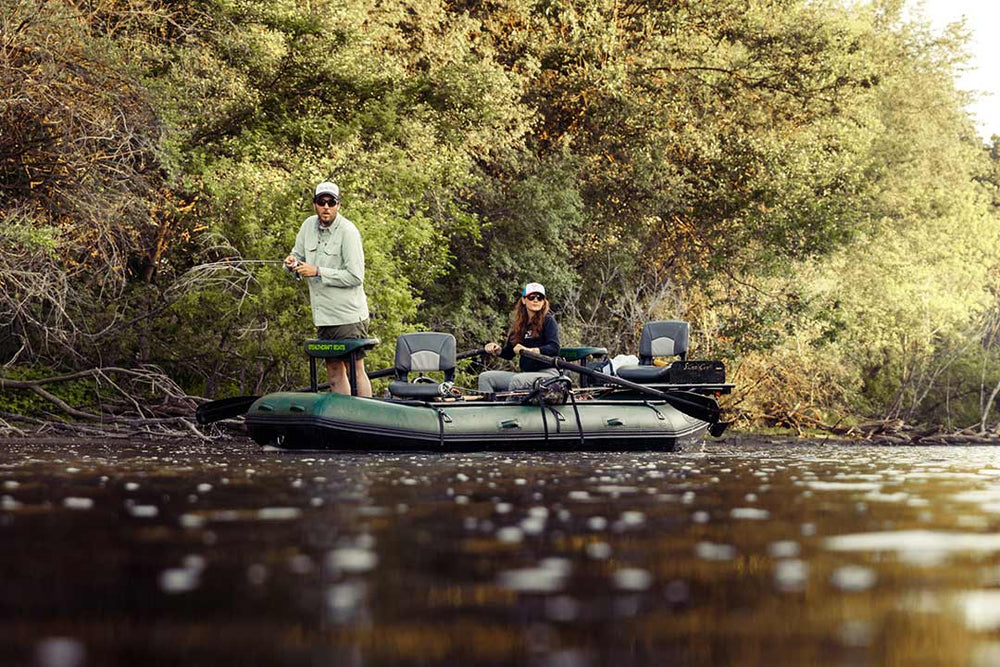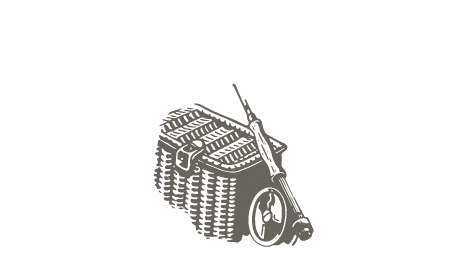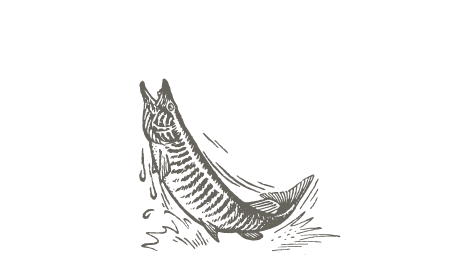Landing, Handling, and Releasing Musky
While I might be proud of the fish in this photo, I am not particularly proud of how I handled it. I succumbed to a few classic errors. As Keep Fish Wet says, “the fate of the released fish is primarily determined by angler behavior.” We all love these toothy critters so it is important that we recognize and learn from these mistakes. We have to try to make sure we have the right tools and ‘know how’ for healthy catch and release practices, especially with big fish such as musky. We have partnered with Keep Fish Wet to help educate new musky anglers and refresh the old veterans.
Musky fishing is nearly all a catch and release sport thanks to the hard work and mission of organizations like Muskies, Inc. and the anglers that adopted the practice thereafter. If you don’t have the right tackle, tools, and education on how to handle musky you might want to pause before you go on your next adventure.
We recommend - 1) long nose pliers, 2) hook cutter ideally Knipex, 3) jaw spreader, 4) rubberized or knotless nylon landing net big enough to fit a small human, 5) wire bite guard on your leader 6) appropriate sized hooks (3/0 to 8/0) and 7) and a fly rod sturdy enough to land a musky. We recommend at least a 10wt.
We will go into more detail on each of these below and tell you where you can find them. We will summarize some of the great research done by our partners at Keep Fish Wet and add layers to make it specific for musky. If you want to read the full scientific paper, here is the link.
At a high level the best practices can be summarized in two points:
-
Have the right equipment for the job.
-
Reduce air exposure, stress, and slime loss - a.k.a KEEP FISH WET!
First, a word about fish mortality:
It happens. Fishing, even catch and release fishing, is a blood sport. But as conservationists it is our responsibility to employ practices that heavily reduce the likelihood of mortality. Jordan Weeks, Senior Fisheries Biologist at the Wisconsin DNR, mentioned in a recent Musky360 podcast that most dead fish don’t float and that no matter what an angler does to mitigate angling mortality every capture carries a 5-10% mortality chance for the fish. We hope that by learning and using the tactics below we can all be better anglers and conservationists of the fish we love. Check out this podcast from Musky360 featuring Jordan Weeks to learn more about musky mortality.
Landing:
The goal of landing a fish is to get it into the net. So what do we need to do to make sure our landing practices line up with the scientific research for effective catch and release?
-
Reduce the fight and get the fish landed as quickly as possible - The fight puts stress on the fish and by postponing the landing we are adding unnecessary stress. This is one of the key reasons for a 10wt or bigger. Sure it is better for casting big flies, but it is also optimal for landing big musky quickly. There is no scientific evidence that we are aware of that correlates rod weights with fish mortality, but nonetheless we prefer 10wts or bigger.
-
Barbless hooks - This is a big debate, but we prefer to go barbless. Overall, the science here shows minimal difference between barbed and barbless with 4.6% and 4.2% mortality rates respectively. It also helps to know that when you are whipping big ass hooks around your head you don’t have a barb in your hook when you need to pull it out of your skin. (Just ask my wife how she felt when I had to pull my barbed hook out of her neck.)
-
Landing Nets - We believe in landing nets for musky. Cradles are ok, but the difficulty of use especially for a solo angler leads us to always recommend a landing net over a cradle. For the net, it should be knotless nylon or (even better) rubberized. The bag should be big enough to hold a small human. Our favorite net for healthy catch and release is the Stowmaster Tournament Series in 94 or 116 inch. This net is big enough to land world record musky and to provide you ample room to unhook and handle the fish while keeping them secure and in the water.
Appropriately sized holding vessels not only increase the probability of effectively landing a hooked fish, but may also serve as a vessel for retaining the fish, submerged in water, for a short period while other tools are prepared for unhooking, measurement, and/or picture taking/admiration
-Jacob W. Brownscombe, Andy J. Danylchuk, Jacqueline M. Chapman, Lee F.G. Gutowsky, Steven J. Cooke (Link)
Handling:
The act of handling a musky is one area we see the most error and it is also where some of the most damage can be done to the fish. This is why we are excited to partner with Keep Fish Wet to help spread their mission. We all know how cool grip and grin photos are and on the surface they are not bad. The issue we have is that most of these photos include large fish being handled incorrectly - either grabbing the fish in the wrong spot, holding it the wrong way, holding the fish over the boat instead of the water, and holding the fish out of the water for far too long.
Here are some rules we live by when fishing for musky that might be of help to you:
Keep your hands wet at all times. Gloves don’t really make a difference as long they are not rough textured ones. Hands (wet or dry) with sunscreen, however, can be very detrimental to the fish.
While many anglers believe handling fish with gloves is an effective mitigation tactic, few scientific studies have addressed this issue, and none we are aware of have shown they reduce slime loss over bare hands. Hannan et al. (2015) showed that sunscreen-coated hands cause significantly greater fungal infections than wet hands when handling bonefish. Clean, wet hands or non-abrasive gloves both likely serve well for handling fish.
-Jacob W. Brownscombe, Andy J. Danylchuk, Jacqueline M. Chapman, Lee F.G. Gutowsky, Steven J. Cooke (Link)
Learn holding techniques - we prefer to hold them by the tail while keeping them in the water. Do not use mechanical gripping devices! When lifting a musky up be sure of two things 1) you are holding the fish securely either via the tail or the gill plate. Do not touch the gills! And 2) that you are supporting the fish’s spine by holding them horizontally.
Danylchuk et al. (2008) showed mechanical gripping devices cause significant physical damage to mouth structures in bonefish, including injuries as severe as broken jaws and separation of the tongue from the floor of the mouth.
Newman et al. (1986) found that novice anglers took significantly longer to unhook angled muskellunge than experienced anglers. It is intuitive that less experienced anglers would be less effective at removing hooks quickly and without injuring fish, likely due to a combination of a lack of knowledge and motor skills for the procedure.
-Jacob W. Brownscombe, Andy J. Danylchuk, Jacqueline M. Chapman, Lee F.G. Gutowsky, Steven J. Cooke (Link)
If you are in doubt about how to handle a musky, the best tactic is to keep the fish in the water at all times. This means your hands will always be wet and so will the fish. It also means the water will support the fish’s spine and you don’t have to lift it by the gill plates which introduces the risk of touching their gills.
Unhooking:
This is the part where having the right unhooking tools is critical. Musky Fool is still working to source the best tools for you and this post was too important to hold until then. In the meantime, visit your local hardware store for the following:
-
An 11 inch long nose pliers
-
A sturdy hook or wire cutter like Knipex
-
A jaw spreader
The goal here is again to keep the fish wet and ideally in the net while you quickly and cleanly unhook the fish. We have all been there where a musky inhales a lure or fly. When this happens and you are unable to easily remove the hook it is best practice to cut the hook or the line as quickly as possible.
Pliers or specially designed unhooking devices are often essential for quickly removing hooks from fish tissue (to reduce handling time) and with minimal damage. These tools are especially useful for unhooking fish species with sharp teeth or bony mouth parts, and generally in instances where fish are hooked deep in the mouth. However, if fish are hooked in sensitive tissues (most commonly the esophagus), cutting the hook or line and leaving the hook in the tissue often results in less injury, physiological disturbance, and greater survival than hook removal.
-Jacob W. Brownscombe, Andy J. Danylchuk, Jacqueline M. Chapman, Lee F.G. Gutowsky, Steven J. Cooke (Link)
Measurement and Documentation:
When fishing for musky, you have the chance to catch the biggest fish of your lifetime. You put in so many hours for this fish that we know a little measurement and photo is important. That being said, like all the other aspects of catch and release, there is a way to do it that dramatically increases the musky’s chance of survival.
You have probably gotten the point by now… when measuring and documenting, KEEP THE FISH WET! If the fish is wet in the water throughout the whole process the chance of a healthy release is much higher!
We do use and encourage bump boards but on one condition. Keep the bump board in the water and not on the floor of the boat when measuring your fish. The bump boards that we sell are designed to float and are the perfect tool for measuring your fish in the water with limited handling! We do not encourage, especially for new anglers, to weigh the fish.
Weighing fish is a well-established tradition in angling culture as a standardized method for quantifying catch size (Arlinghaus et al., 2007). Traditional weighing protocols typically involve hanging fish vertically from a scale using a large hook or gripping device slung by the base of the operculum or lower lip. This process can be detrimental to fish health because it is potentially damaging to gills or mouth structures (Danylchuk et al., 2008), while hanging fish vertically may damage internal organs and vertebrae, tear opercular tissue, while also involving air exposure [see Handling above]. For this reason, there is currently a movement toward changing standard fish measurements from weight to length.
-Jacob W. Brownscombe, Andy J. Danylchuk, Jacqueline M. Chapman, Lee F.G. Gutowsky, Steven J. Cooke (Link)
Get pictures quickly and have your camera ready. If you are not ready for a picture, keep the fish in the net! Ideally we recommend that fish are photographed either fully or partially submerged in water. When you bring the fish up and into the boat you introduce serious risk of injuring the fish. Musky are incredibly large and powerful and despite all the practice in the world they can wiggle away from you while you are handling them. We really encourage anglers to take their measurements and pictures of the fish while it is in the water. Get out of the boat if you have to! You just put a hook into the fish’s mouth and likely caught the fish of a lifetime….your wet socks will dry, so get out of the boat!
Release:
Overall the goal is to minimize fighting stress, reduce air exposure, unhook the fish quickly and cleanly, and reduce contact with surfaces (such as hands, boat, etc.) that will remove slime. When these practices are employed, musky stand a far better chance of being released without mortality. If you follow these tips we guarantee you will have more success releasing healthy musky. If you are interested in more detail on this topic check out the full article from our amazing friends at Keep Fish Wet or reach out to us at shop@muskyfool.com.
Overall, we cannot tell you how to handle your fish. All we hope to do with this post is share what some of the science tells us and what we have learned in our own fishing experience.
And finally, since this is a heavy topic albeit an important one…be sure to have fun out there this fall!
Sources:
-
https://www.keepfishwet.org/keepemwet-news-1/2017/1/6/best-practices-for-catch-and-release-recreational-fisheries-anglingtools-and-tactics
-
https://www.musky360.com/articles-1/c/0/i/48203694/article-1053






Leave a comment